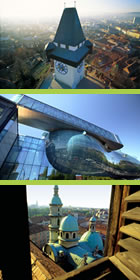 Graz has a long and fascinating history. Its strategic location on the river Mur and with the Schlossberg, a steep rocky outcrop, providing protection and shelter, proved a powerful magnet already in pre-historic times. The first permanent settlement was established around 3000 BC, as is testified by recently excavated artefacts from the copper-age period.
Graz has a long and fascinating history. Its strategic location on the river Mur and with the Schlossberg, a steep rocky outcrop, providing protection and shelter, proved a powerful magnet already in pre-historic times. The first permanent settlement was established around 3000 BC, as is testified by recently excavated artefacts from the copper-age period.
Today Graz is the administrative capital of Styria, and with a population of 292,000, the second-largest city in Austria. Graz is a thriving commercial and industrial centre and home to many leading businesses. The city is also Austria’s main gateway to south-eastern Europe, an area with a population of over 50 million people. Graz boasts a highly educated workforce, of which a fourth have tertiary level qualifications, and is known for its outstanding training and education opportunities. Graz is moreover a safe city with a very low crime rate, an attractive residential environment, excellent medical care and a generous social welfare system.
Multilingual roots. The name of Graz derived from the old Slovenian word gradec meaning small fort. The first permanent settlement was established by Slavic tribes between 600 and 700 AD. They were joined in the eighth century by Bavarii and Franks, who brought with them Christianity. Soon, the Slavs were assimilated by the new settlers.
The earliest documentary evidence for Graz dates from 1128. Two and a half centuries later, in 1379, Graz became the chief residence of the Habsburgs, which it remained until 1619. The city’s distinctly southern feel dates back to the Renaissance period, when Italian architects were brought in and designed some of the city’s most famous buildings. Imposing fortifications were at the time also erected on the Schlossberg. Although never conquered by enemy forces, the fortress was razed in 1809 after Austria’s defeat by Napoleonic troops. The only structures to escape destruction were the bell tower and the clock tower. They were redeemed by the citizens of Graz and are now the city’s much admired and cherished landmarks.
Multicultural tradition. Graz is located in an area where many cultural traditions meet and merge. The cityscape represents a blend of Romanesque, Slavic, Hungarian and Germanic-alpine influences, which are reflected in an exciting variety of styles. Superb examples of Gothic, Renaissance, Baroque, Historicist and Art Nouveau architecture stand side by side with award-winning modern buildings which were thoughtfully designed to provide both a contrast to and to complement the setting. The unique character of the Old Town was officially recognised in 1999 when UNESCO included Graz on its list of world heritage sites. This commitment to a multicultural society is as strong as it is historic and lies at the heart of the city’s cultural and political identity. Graz is today a platform for international meetings, intercultural and inter-religious dialogue. In 2001 Graz was named the first European Human Rights Capital by the United Nations, and in 2003 Graz was the European Capital of Culture.
Linguistic diversity. Graz is committed to linguistic diversity. The city is home to the European Centre for Modern Languages, which was established by the Council of Europe to promote and support measures aimed at strengthening multilingualism in the member states. Over a 150 languages are spoken by the city’s residents. Local schools also offer a wide choice of modern languages: Graz schoolchildren can choose between fifteen foreign languages, while mother-tongue teaching for migrant children is available in seventeen languages. Linguistic diversity is also supported by the University of Graz. The School of Translation and Interpreting, English and American Studies, Romance Studies and Slavonic Studies offer a total of twelve modern languages. A strong commitment to plurilingualism also informs the work of treffpunkt sprachen, the university’s language centre, and is central to the teaching of the two teacher training universities. The promotion of multilingualism is also at the heart of the Graz Bilingual School (GIBS) and at the core of its efforts to create an environment that enables teaching, learning and communicating in several languages. Graz is also home to the Austrian Centre for Language Competence, which has responsibility for supporting innovation and the further development of language learning and teaching in the country.
Übersetzung: Ursula Stachl-Peier